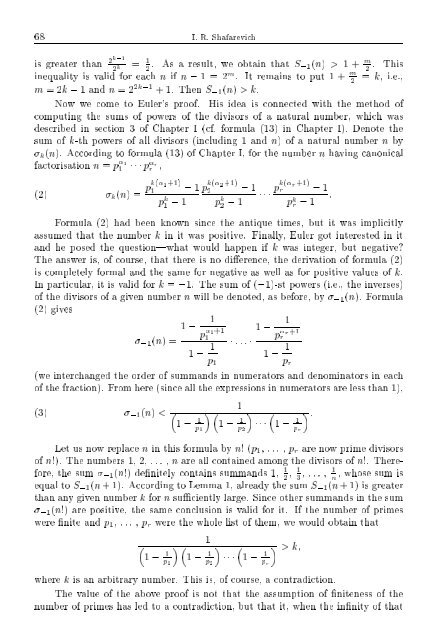SELECTED CHAPTERS FROM ALGEBRA I. R. Shafarevich Preface
SELECTED CHAPTERS FROM ALGEBRA I. R. Shafarevich Preface
SELECTED CHAPTERS FROM ALGEBRA I. R. Shafarevich Preface
You also want an ePaper? Increase the reach of your titles
YUMPU automatically turns print PDFs into web optimized ePapers that Google loves.
68 I. R. <strong>Shafarevich</strong>is greater than 2k;12 k = 1. As a result, we obtain that S 2 ;1(n) > 1+ m. This2inequality is valid for each n if n ; 1 = 2 m . It remains to put 1+ m = k, i.e.,2m =2k ; 1 and n =2 2k;1 +1. Then S ;1 (n) >k.Now we come to Euler's proof. His idea is connected with the method ofcomputing the sums of powers of the divisors of a natural number, which wasdescribed in section 3 of Chapter I (cf. formula (13) in Chapter I). Denote thesum of k-th powers of all divisors (including 1 and n) of a natural number n by k (n). According to formula (13) of Chapter I, for the number n having canonicalfactorisation n = p 11 pr r ,(2) k (n) = pk(1+1) 1; 1p k 1 ; 1p k(2+1)2; 1p k 2 ; 1 pk(r+1) r ; 1p k r ; 1 :Formula (2) had been known since the antique times, but it was implicitlyassumed that the number k in it was positive. Finally, Euler got interested in itand he posed the question|what would happen if k was integer, but negative?The answer is, of course, that there is no dierence, the derivation of formula (2)is completely formal and the same for negative aswell as for positive values of k.In particular, it is valid for k = ;1. The sum of (;1)-st powers (i.e., the inverses)of the divisors of a given number n will be denoted, as before, by ;1 (n). Formula(2) gives1 1 ;p r+1 r ;1 (n) =1 ; 1p 1+111 ; 1 p 1 ...1 ; 1 p r(we interchanged the order of summands in numerators and denominators in eachof the fraction). From here (since all the expressions in numerators are less than 1),(3) ;1 (n) k1 ; 1 p 11 ; 1p 21 ; 1p rwhere k is an arbitrary number. This is, of course, a contradiction.The value of the above proof is not that the assumption of niteness of thenumber of primes has led to a contradiction, but that it, when the innity ofthat
















